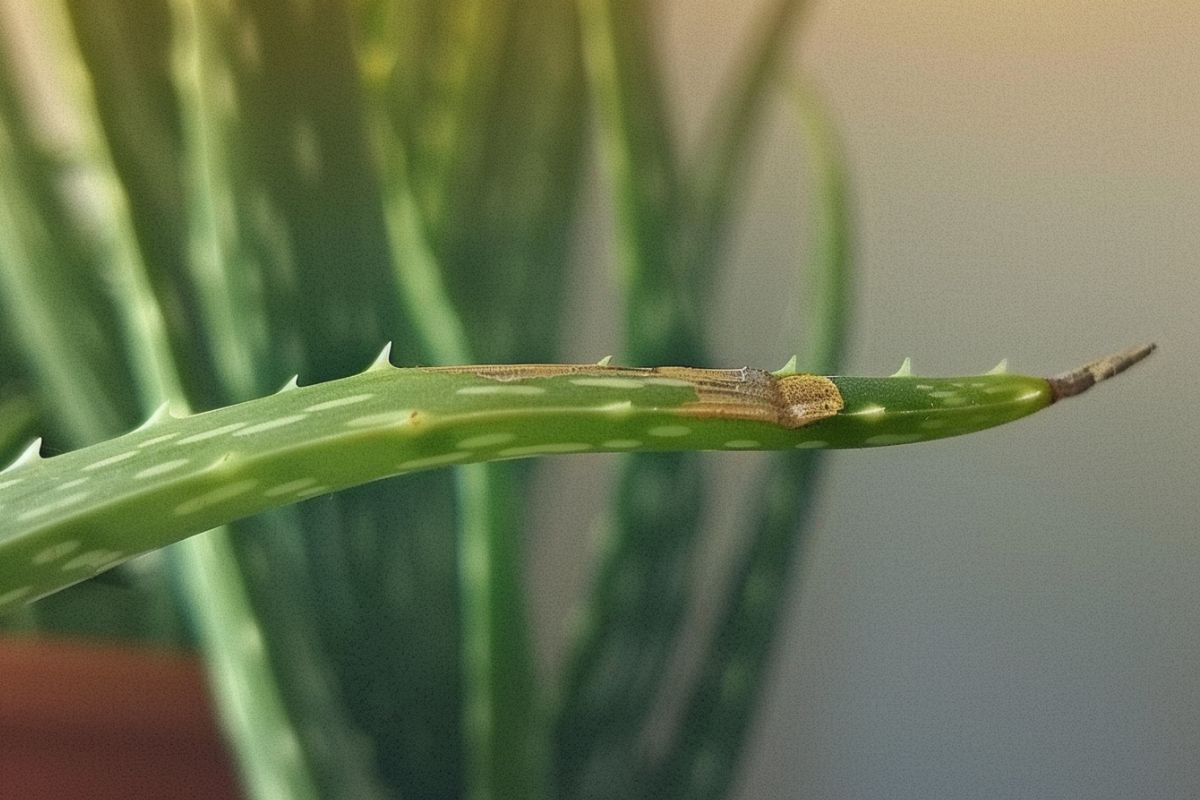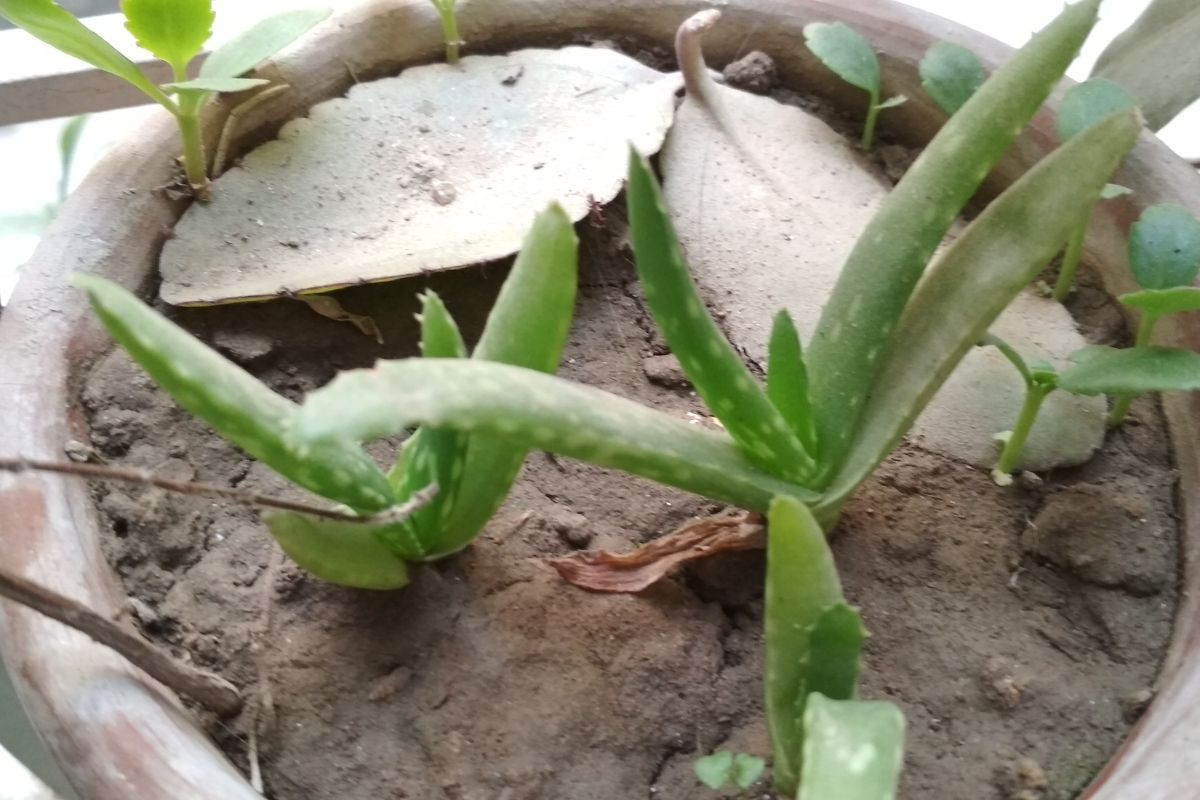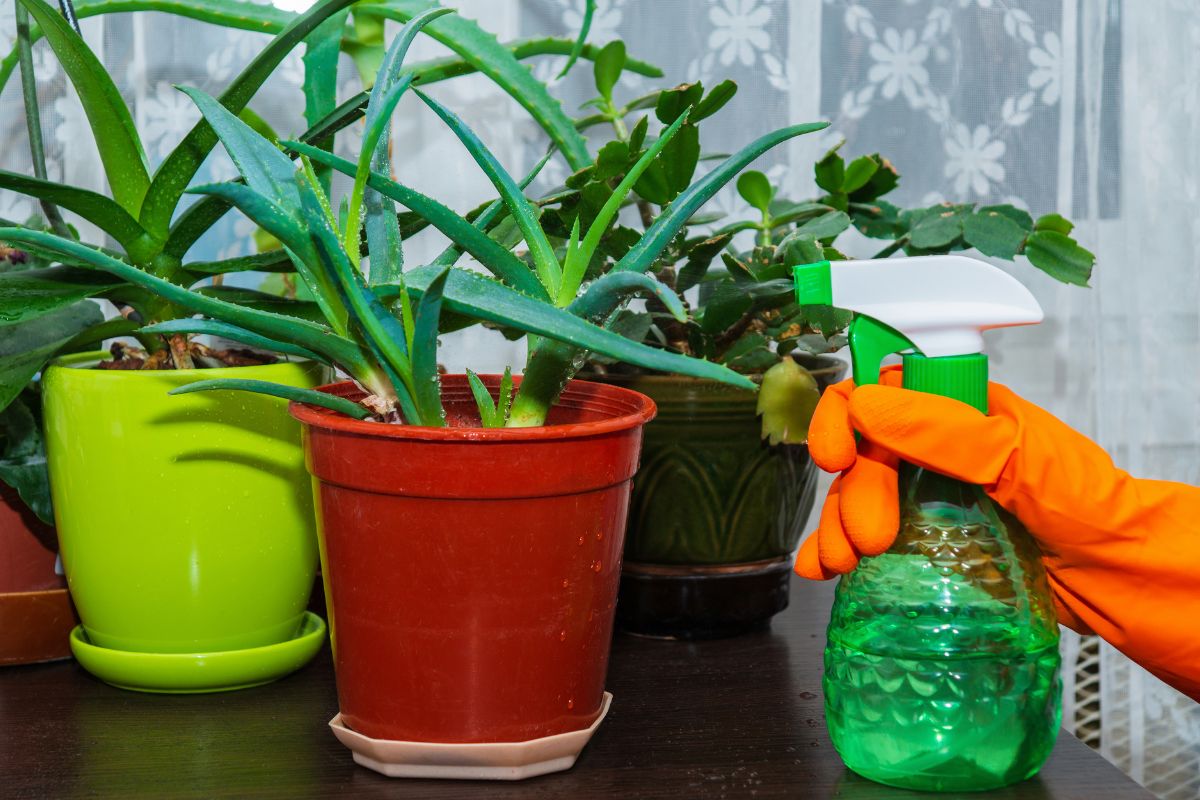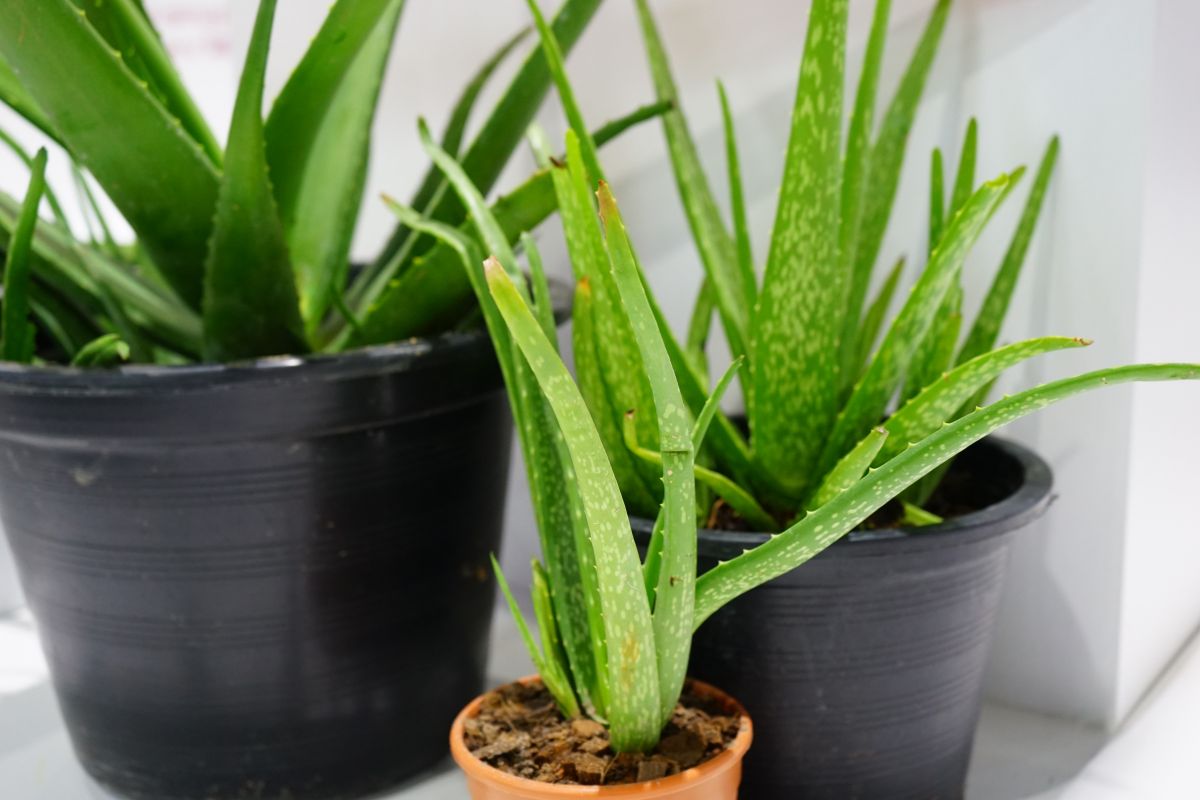Is your aloe plant looking a bit sad? You might be dealing with an underwatered aloe plant. These resilient beauties can survive in dry conditions, but they still need your help to thrive.
This guide will dive into the signs that indicate your aloe vera is thirsty, like yellowing leaves or drooping stems. You’ll also learn practical solutions to revive your plant and how to prevent future underwatering issues.
Don’t let your aloe suffer in silence! Keep reading to discover how to keep your aloe plant healthy and happy, ensuring it continues to bring beauty and benefits to your home.
- Related article: Growing Guide for Aloe Vera
7 Key Takeaways on Underwatered Aloe Vera Plant
- Aloe vera plants show signs of underwatering such as yellowing leaves, brown tips, and dry, brittle roots.
- To revive an underwatered aloe vera, trim damaged leaves, water thoroughly, and ensure proper drainage.
- Check the soil moisture regularly by inserting your finger 2 inches deep and use a moisture meter for accuracy.
- Establish a consistent watering schedule: once a week during the growing season and every two weeks during dormancy.
- Plastic pots are beneficial for aloe vera as they retain moisture longer and reduce watering frequency.
- Always ensure the pot has drainage holes to prevent waterlogging and potential root rot.
- Be patient with recovery, as it may take several weeks for the aloe vera plant to show improvement.
Signs Your Aloe Vera Plant Is Underwatered
There are several signs that the aloe vera plant will give you to let you know whether or not it needs water.
1. Aloe Vera Leaves Are Turning Yellow

One key sign that your aloe vera plant is underwatered is when its leaves turn yellow. When the plant doesn’t get enough water, the vibrant green leaves lose color and start to look yellow.
I’ve seen this happen because the plant struggles to take in nutrients without enough moisture. The yellowing of your aloe vera leaves usually begins at the tips or edges and then spreads inward.
It’s important to notice this early. If you let the underwatering go on, it can lead to bigger problems. If you spot yellow leaves on your aloe, adjust your watering routine. Just be careful not to overcorrect because too much water can cause the same yellowing.
2. Aloe Vera Leaves Are Turning Brown

When your aloe vera plant doesn’t get enough water, the edges of the leaves turn brown. This browning starts at the tips and moves inward. The plant does this to save water by letting some parts dry out. Over time, the leaves may curl or get thinner as they try to hold onto moisture.
You might also see brown spots on the leaves. These spots start small but grow if the plant stays thirsty. They usually appear on the older, lower leaves first. The spots feel dry and crispy, like paper, showing clear signs of dehydration.
If you notice brown edges, brown spots, or thinning leaves, check the soil moisture. Adjust your watering schedule quickly to stop more damage. Once the leaves turn brown, they won’t go back to green. So act fast to keep your aloe vera healthy.
3. Aloe Vera Leaves Are Drooping
When my aloe vera doesn’t get enough water, its usually firm leaves start to droop and lose their shape. This drooping happens because the plant tries to save moisture, which reduces the pressure inside the leaves.
You might also see other signs, like thinning or curling leaves. This is another case where you will need to change your watering schedule right away to help your plant recover. This simple action can bring your aloe vera back to good health and stop any further damage.
4. Aloe Vera Leaves Are Curling
Aloe leaves curling often means that it’s not getting watered often. Its leaves start to curl inward, a sign that its health is starting to deteriorate. This curling helps the plant save moisture by making its surface area smaller.
You might see other signs of dehydration too. The leaves can thin out or turn brown. It’s important to change your watering routine quickly. Make sure the soil stays moist but not soaked.
5. Aloe Vera Potting Soil Is Dry

When the soil gets too dry, it shows that your aloe vera is not getting watered enough. Aloe vera likes well-draining soil, but it still needs regular watering.
If the soil is too dry, it can’t give your plant’s roots the moisture they need. This can lead to the other problems I just mentioned — leaf curling, browning, and drooping. Water your aloe vera well but not too often. Make sure the soil stays a little moist between waterings.
6. Aloe Vera Has Brittle Roots
When your aloe vera’s roots start getting brittle, it may be a sign that it’s getting thirsty too often. Brittle roots feel dry and can easily break. This happens because the plant lacks moisture, which leads to root dehydration.
Brittle roots hurt the plant’s ability to absorb nutrients and water. This makes the problem worse. Like all the other issues, watering regularly is the answer. Check the soil to see if it feels dry before adding more water. If you notice brittle roots, act quickly to revive your plant.
How to Revive an Underwatered Aloe Vera Plant

There are several ways to bring an underwatered aloe vera plant back to life. While there are no guarantees, you can try these steps if your plant still shows some signs of life:
- First, assess the plant. Look for signs like yellowing leaves, drooping or wilting leaves, brown tips, and dry, wrinkled leaves. These indicate underwatering.
- Next, remove any damaged parts. Use clean scissors to trim off the worst leaves. This helps the plant focus on healing.
- Check the soil next. Make sure the potting soil is completely dry. If it’s not, wait until it dries out before watering.
- Give the aloe a thorough watering. Allow water to flow out of the drainage holes. This helps rehydrate the roots and soil.
- Ensure proper drainage. The pot should have enough holes to prevent water from sitting at the bottom.
- Place the plant in indirect sunlight. Find a spot with bright light but avoid direct sun while the plant recovers.
- Monitor the soil moisture. Let the top inch of soil dry out between waterings. Aloe plants like to dry out a bit before the next drink.
- Adjust your watering schedule. Water thoroughly but less often, about every 2-3 weeks, depending on the environment.
- If needed, improve soil conditions. You might want to repot in a well-draining soil mix made for succulents.
- Be patient. It can take weeks for your aloe to show signs of recovery. Keep providing care and watch its progress.
Once the plant recovers, maintain proper care. Give it 3-4 hours of direct morning sun and water only when the soil is dry. This helps prevent future underwatering problems.
Tips to Prevent Underwatering the Aloe Vera Plant
Now that you’ve repotted the aloe plant, you’ll want to keep in mind how to prevent underwatering in the future.
Here are some pro tips to avoid underwatering:
1. Keep an Eye on the Soil Moisture Levels
To keep your aloe vera plants healthy, check the soil often. Stick your finger about 2 inches into the potting mix. If it feels dry, it’s time to water. You can also use a moisture meter for a more accurate reading.
When you’re watering aloe vera plants, make sure to soak the soil well. Let any extra water drain out. Aloe vera plants do better with less water, so it’s safer to underwater than to overwater. Adjust your watering routine based on how your plant looks and the weather.
2. Set a Watering Schedule and Adjust Occasionally
You need a good watering schedule for aloe vera to keep your plant healthy. This helps avoid underwatering.
When it’s growing, water your plant once a week in spring and summer. During the fall and winter, cut back to watering every two weeks.
You should also change this schedule based on the temperature and humidity around your plant. Before you water, check the soil. If the top 2-3 inches feel dry, it’s time to water.
Sticking to this routine keeps the soil moist and helps your aloe vera thrive. Regular watering means less stress for your plant.
3. Try a Plastic Pot

Using a plastic pot for your aloe vera plant can help you avoid underwatering. Plastic pots hold moisture longer than terracotta or clay pots. This means you won’t have to water as often, which is great if you sometimes forget.
Make sure your pot has drainage holes. This prevents water from building up, which can lead to root rot. A plant tray will catch any extra water.
Choose well-draining soil for your aloe. A cactus mix works well to keep moisture balanced. Too much water can harm your plant.
Underwatered Aloe Vera Plant Final Thoughts
Your aloe plant can handle dry conditions, but it still needs water. Make sure you give it enough moisture.
Watch for signs that it needs more water. If the leaves turn brown or droop, or if the soil feels dry, it’s time to act. You should water your aloe more often.
If your plant shows signs of life, you can bring it back. However, it’s best to prevent underwatering in the first place. We all care for our aloe plants and don’t want them looking unhealthy.
Underwatered Aloe Vera Plant FAQs
1. How Can I Tell If My Aloe Vera Plant Is Underwatered?
Aloe vera plants show several signs of underwatering, including yellowing leaves, brown leaf tips or edges, brown spots, drooping or curling leaves, and dry, brittle roots. Checking the soil for excessive dryness and observing these symptoms will help you determine if the plant needs more water.
2. What Is the Best Way to Water an Underwatered Aloe Vera Plant?
Water your aloe vera plant thoroughly but infrequently. When you water, ensure the water flows through the drainage holes at the bottom of the pot. This helps rehydrate the roots and soil. Allow the top inch of soil to dry out between waterings, and adjust your schedule based on environmental conditions.
3. Can I Save an Aloe Vera Plant That Has Already Developed Brittle Roots?
Yes, you can attempt to revive an aloe vera plant with brittle roots. Start by trimming off any damaged leaves, checking and correcting soil moisture, and ensuring proper drainage. Water the plant thoroughly and use a well-draining soil mix. Monitor the plant’s progress and be patient, as recovery may take several weeks.
4. How Often Should I Water My Aloe Vera Plant During Different Seasons?
During the growing season (spring and summer), water your aloe vera plant once a week. In the dormant period (fall and winter), reduce watering to once every two weeks. Adjust this schedule based on environmental factors like temperature and humidity.
5. Is It Better to Use a Plastic Pot or a Terracotta Pot for Aloe Vera?
Plastic pots are generally better for aloe vera plants as they retain moisture longer than terracotta or clay pots. This helps reduce the frequency of watering and is useful if you might forget to water regularly. Ensure the pot has drainage holes and use well-draining soil to prevent root rot and excess moisture buildup.
Other articles on caring for the aloe vera plant:




